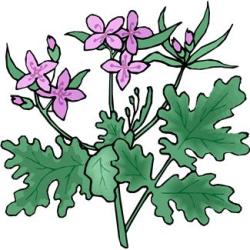Source Institutions
Source Institutions
Add to list Go to activity
Activity link broken? See if it's at the internet archive

This activity provides an opportunity for learners to observe and examine how carbon dioxide, water, and light produce glucose/starch through a process called photosynthesis. This process is validated through the production of starch picture images produced on a geranium leaf. The fundamental question answered by this activity is: "What actually occurs in plant leaves as a result of photosynthesis?" Learners construct a hypothesis, set up and run the experiment, record observations, and answer reflection questions. This resource guide includes assessment and extension suggestions. When executing this lab, safety precautions involving boiling alcohol should be strictly followed.
- 30 to 45 minutes
- 1 to 7 days
- $5 - $10 per group of students
- Ages 14 - 18
- Activity, Experiment/Lab Activity, Lesson/Lesson Plan
- English
Quick Guide
Materials List (per group of students)
- Geranium Plant (mature with non-variegated leaves at least 3 inches x 3inches)
- Slide Projector, with carousel and selected slides (very contrasting and distinct)
- Glass Plates (3" x 3" in area)
- 5% Sodium Bicarbonate Solution
- Lugol's Solution
- Ethanol
- Pipettes
- Ringstand
- Test Tube Clamps
- Rings and Screens
- Paper Clamps (1-2" in length)
- Watch Glasses or Small Glass Dishes (must hold approximately 8-10ml of water)
- Forceps and Tongs
- Hot Plates
- Large Glass Dishes (must easily accommodate 3"x3" leaf and 50ml of water)
- Water Bottles (optional)
Subjects
-
Life Sciences
- Cells
-
Diversity of Life
- Plants
-
Physical Sciences
-
Chemistry
- Chemical Reactions
-
Vibration and Waves
- Light and Optics
-
Chemistry
-
The Nature of Science
-
The Scientific Process
- Conducting Investigations
- Gathering Data
- Formulating Explanations
- Communicating Results
-
The Scientific Process
Informal Categories
- Gardening
- Nature and Environment
- Photography and Film/Video
Audience
To use this activity, learners need to:
- see
- see color
- touch
Learning styles supported:
- Links STEM to other topics of interest such as arts and humanities
- Involves hands-on or lab activities
Other
Includes assesments for student learning:
This resource is part of:
Access Rights:
- Free access
By:
- Morishita, C. Ford
Rights:
- All rights reserved, Access Excellence @ the National Health Museum, 2009
